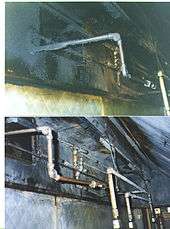Kitchen exhaust cleaning

Kitchen exhaust cleaning (often referred to as hood cleaning) is the process of removing grease that has accumulated inside the ducts, hoods, fans and vents of exhaust systems of commercial kitchens. Left uncleaned, kitchen exhaust systems eventually accumulate enough grease to become extreme fire hazards.[1][2] Exhaust systems must be inspected regularly, at intervals consistent with usage, to determine whether cleaning is needed before a dangerous amount of grease has accumulated.
Cleaning processes
The exhaust system is first scraped clean, then washed clean with food-safe caustic chemicals and hot water pressure-washing where possible to safely collect the dissolved grease and water. The actual commercial kitchen exhaust system cleaning guidelines are outlined in the National Fire Protection Association (NFPA)
Caustic chemicals
Caustic chemicals can be applied to break down the grease. After that, hot water can be used to rinse away the residue. Chemicals are generally applied with either a garden type sprayer, downstream injection through a pressure washer or with a chemical foamer.[3]
Once the chemicals are applied, they are allowed to dwell on the surface of the grease for a period of time, before being washed off of the surface with hot water. In extreme situations, where grease buildup is too heavy for a chemical application and a rinse, scrapers may be used to remove excess buildup from the contaminated surfaces, before chemicals are applied.[4]
Hot water pressure-washing
Machines can be used that both boil water and then apply this water under pressures up to 2,000 pounds per square inch (14,000 kPa). In a common method of preparation, heavy-duty tarps are first clipped to the hoods and then angled into plastic garbage cans to catch the run-off. As the cans are filled the contents are disposed of successively. The grease should be removed rather than just emptied into the local drains to avoid clogging issues.
Finishing
Cleaners often polish hoods for easier cleaning and improved appearance. Cleaners apply a certification sticker to the hood of each cleaned kitchen exhaust system to enable the authority having jurisdiction as well as insurance adjusters, health inspectors to check for compliance with the local and County, State fire codes. Too add, the cleaning frequency depends on the type of food being cooked and volume of grease laden vapors drown up through hood plenum. For example, a church may require less service intervals because they may only use 10 tim es a year, however the church down the street would require more because they have a Friday night fish every week. Range from Monthly, every two months, quarterly, and Semi Annual and annual.[5]
Regulation
Many jurisdictions have adopted this nations minimum available standard, National Fire Protection Association Standard 96, Standard for Ventilation Control and Fire Protection of Commercial Cooking Operations,[6][7] and require compliance to it by Kitchen Exhaust Hood Cleaners and operators of commercial kitchens.
Industry education
Several associations have been formed to educate kitchen exhaust cleaners on the provisions of NFPA 96 standard and on the best standards and practices for kitchen exhaust cleaning. Among these are:
- Member of the NFPA Education Section
- Hood Cleaning School.
- Power Wash University
- International Kitchen Exhaust Cleaning Association
- Power Washers of North America
- Certified Hood and Duct Cleaners Association.
Each organization has its own philosophies, but they all have the goal of improving the kitchen exhaust cleaning industry.
References
- ↑ "Boston fire's fuel apparently missed". Firerescue1.com. 2007-09-07. Retrieved 2013-12-01.
- ↑ "3D FIREFIGHTING - LATEST NEWS". Firetactics.com. 2007-08-29. Retrieved 2013-12-01.
- ↑ "Cleaning to a higher standard". IKECA. 2013-10-03. Retrieved 2013-12-01.
- ↑ "Cleaning to a higher standard". IKECA. 2013-10-03. Retrieved 2013-12-01.
- ↑ Safeguard.enterprise-Jason Hofstein
- ↑ "NFPA 96: Standard for Ventilation Control and Fire Protection of Commercial Cooking Operations: About the Codes". Nfpa.org. Retrieved 2013-12-01.
- ↑ "NFPA 96: Standard for Ventilation Control and Fire Protection of Commercial Cooking Operations". Nfpa.org. Retrieved 2013-12-01.
| Wikimedia Commons has media related to Kitchen Exhausts. |